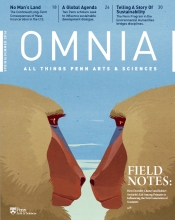When Earthworms Are Earth Savers
Emma Harrison, a doctoral candidate in earth and environmental science, examines the role of these natural excavators in topsoil stability.
When people hear the phrase “nonrenewable resource,” they usually think of fossil fuels such as crude oil, natural gas and coal—all of which take billions of years to form from organic matter contained in earth. But what about an equally vital resource: topsoil? This topmost layer of earth, about two inches deep, contains a rich mix of minerals that supplies most nutrients for plants. One inch of topsoil—vital to the world’s food supply—takes more than 10,000 years to make.
“It amazes me that topsoil is not generally regarded as a fundamental resource,” says Emma Harrison, a doctoral candidate in the Department of Earth and Environmental Science. “Without it, there would be no food supply for our planet.”
Harrison studies the effects of erosion on topsoil, particularly erosion caused by landslides, which are a major problem in agriculture worldwide. In her field research in the mountains of northeast Puerto Rico, she uncovered an unexpected protector of this rich and nutrient-dense layer of soil: massive earthworms that grow as long as a person’s forearm.
“The worms burrow deep into the earth and create tunnels,” Harrison explains. “They act as natural excavators and flush excess water out of the soil so the soil doesn’t become waterlogged, which is how landslides start.”
Harrison made this discovery in terrain that is particularly vulnerable to flooding, a mountainous region of Puerto Rico, El Yunque, that sits directly in the path of tropical hurricanes.
“It has one of the highest precipitation rates in the whole country,” Harrison says. “In a normal year it gets 200 inches of rainfall. It’s a given that that much rainfall can send tons of topsoil sliding down the mountains and into the ocean. It’s an incredible loss of a precious natural resource.”
With the abundant moisture entering the soil in El Yunque, the statistical likelihood of landslides is high—at least in theory. But, curiously, Harrison found the opposite. Even in the face of massive rains, the topsoil remained in place. She sought to understand why. It was during her explorations that she observed the giant earthworms and uncovered the underground tunnels they create. Could these creatures be connected to the stability of the topsoil on the mountain?
To find out, she recreated the earthworms’ habitat in a lab at Penn with the help of researcher Aria Kovalovich, C’18. Harrison constructed what was essentially earthworm terrarium using everyday materials from a local hardware store: panes of glass and hollow plastic rods large enough to hold the giant worms. She filled the terrarium with soil she brought to Penn from El Yunque and then placed the worms into this “nest” and photographed their activity every day. Just as they had in their native habitat, they burrowed into the soil and created the tunnels that flush the soil of water. The experiment confirmed Harrison’s hypothesis.
She presented the results of her experiment at a recent meeting of the Geological Society of America, and her work was also reported in the prestigious scientific magazine Earth.
“Since we now understand why erosion has slowed in this particular region, we can identify ways that topsoil can be preserved,” Harrison says. “Anything we can comprehend about underlying reasons for erosion and ways to slow it are critical to the study of this fundamental resource.”



